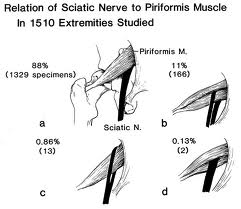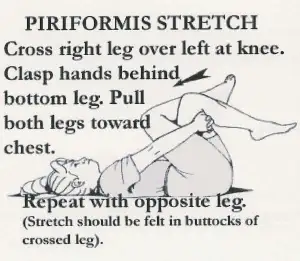What is Piriformis Syndrome?
Ever have a literal pain in the buttock? A gnawing, throbbing, aching pain in the buttock? This could well describe a condition called “piriformis syndrome”
Piriformis syndrome occurs when a the sciatic nerve is affected in the area of the piriformis muscle, resulting in neurologic symproms of pain down the leg and weakness. These symptoms can mimic those of a disc herniation or nerve impingement at the vertebrae, making diagnosis difficult. For this reason, piriformis syndrom is an often missed diagnosis.
Anatomy of the piriformis:
The piriformis one of the muscles found in the buttock area. It lies with a group of small muscles beneath the large gluteus maximus. The piriformis muscle attaches to the front of the sacrum and the greater trochanter of the femur, and works as an external rotator of the leg. Because the piriformis attachment is so close to the spine, many nerve and arteries pass both over and under this muscle. In fact, it has been found that the sciatic nerve, the largest nerve of the leg, passes through the piriformis muscle or tendon in 22% of the population. Therefore, the sciatic nerve is easily affected by this muscle.
Mechanism of injury:

There is no one clear mechanism behind the development of piriformis syndrome. Often, adhesions on the piriformis muscle can be caused by an initial fall to the buttock area, resulting in entrapment of the nerve. The sciatic nerve may be more easily compressed if the nerve passes through rather than around the muscle, causing nerve injury. Other possible causes of piriformis syndrome include prolonged sitting, increased muscle tone and muscle shortness of the piriformis, pregnancy, leg length discrepancy, inflammation of the piriformis, and weakness of the gluteus maximus and hip abductors.
What does piriformis syndrome feel like?
Those who are diagnosed with piriformis syndrome often complain of pain in the low back and/or buttock area. This pain might be neurologic in type- traveling or shooting down the back or side of the thigh or calf. Because the sciatic nerve is primarily affected, sensory changes in the leg may be felt. Symptoms might be increased by prolonged sitting or stretching of the deep gluteal muscles.
What treatment is available for piriformis syndrome?

Once piriformis syndrome is properly diagnosed, there are many treatment options. Myofascial release and trigger point therapy can break up connective tissue adhesions causing entrapment or compression of the nerve. Stretching of the piriformis can also be beneficial to reduce compression and entrapment. Chiropractic manipulations or adjustments can correct abnormal biomechanics, such as a leg length discrepancy and pelvic rotation or malalignment. Modalities such as ultrasound and laser therapy can reduce inflammation and increase tissue healing to the foreshortened piriformis and gluteal muscles. With proper diagnosis and treatment, the debilitating symptoms felt with piriformis syndrome can be reduced or eliminated and you can be on your way to a carefree, free striding walk.